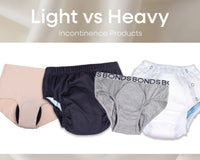Finding the right product for you or someone you care for is essential for comfort and confidence when dealing with incontinence. However, even the best products can sometimes leak. If you’re wondering why this happens and how to prevent it, you’re not alone! Understanding the reasons behind the leaks and how to prevent them is key to managing incontinence effectively.
We explore the top 5 common causes of incontinence leaks and share tips on how to prevent them to ensure you - or the wearer - stay comfortable and confident throughout the day and night.
1. Improper Fitting Incontinence Pads
The number one reason behind a leaking incontinence pad (and possibly the most forgotten) is that it may not be fitting properly! Whether you're using a disposable incontinence pad or a reusable incontinence pad, it needs to fit firmly, comfortably and securely to prevent leakage.
A pad that doesn’t sit snugly against the body can leave gaps around the thighs or waist which will result in leaks - even if your incontinence pad is highly absorbent! To avoid this, make sure to choose the correct size of incontinence pad, that fits well around the legs and waist, as this will minimise the risk of leaks. Correct fit is especially important for nighttime and overnight use, where movement in bed can cause pads to shift.
When shopping for incontinence pads, first measure your waist and hip areas and check the size guides of the product to ensure a secure fit. If you need help measuring these areas, click here.
2. Inadequate Absorbency in Incontinence Pads
Another common reason for leaks is the absorbency level of the incontinence pad. If the pad doesn’t have enough capacity to handle the output or volume of the accident, leaks will happen.
Always choose a pad that matches the incontinence severity, whether it’s for light dribbles or full bladder voids. A product with higher absorbency is needed for heavier incontinence, while a lighter absorbency pad may suffice for occasional leaks such as dribbles or drops.
It's important to ensure that the wearer loses less than the amount of absorbency of the incontinence pad to prevent leaks. This allows the wearer to confidently use the product without fear of it failing.
But how can you determine the right absorbency level? You can start by tracking the wearer’s average output, either through trial and error or by consulting a healthcare professional who can guide you based on the wearer’s condition
3. Rate of Loss
The rate of leakage is just as important as the amount of fluid lost, and will also affect whether the incontinence pad leaks.
If someone is experiencing slow, constant dribbling they may only need a lower absorbency product. However, if they experience sudden, full voids of the bladder or bowel, they will need a pad with high absorbency that can quickly absorb large amounts of fluid.
For light, gradual leakage, reusable Night n Day light incontinence underwear are the perfect solution, designed for minor/slow dribbles. For high-rate leakage, products such as Night n Day All-in-One range of incontinence pads are a better choice.
4. The Frequency of Changing the Incontinence Pads
Another common cause of leaks is not changing the incontinence pad often enough.
A common scenario is that an individual may have no incontinence or very light incontinence during the day where it's easier to recognise and manage when soiling occurs. However, overnight the circumstances can be very different. Even if the incontinence pad has the right amount of absorbency for a full bladder, multiple voids without changing can quickly exceed its capacity. In this case, or for overnight protection, choose a high-capacity product and add an extra layer of protection with the full Night n Day Bed Protection Range
5. Positioning for Male Wearers
For male users, the positioning of the penis can significantly impact leakage in incontinence pads. If the penis is positioned upwards, it may skip or miss the most absorbent areas of the incontinence pad being used, increasing the likelihood of leakage. To minimise leaks, ensure the penis is positioned downward to direct fluid toward the pad’s most absorbent sections. This simple step can greatly reduce leaks and improve overall incontinence pad performance and effectiveness.
Preventing incontinence pad leaks starts with understanding the key factors that influence performance, from ensuring a correct fit, choosing the right absorbency level and managing the frequency of changes. By addressing these common causes, you can significantly reduce the chances of leaks and ensure the wearer stays comfortable and confident throughout the day and night.
At Night n Day, we’re here to help you find the right product for you and your needs, so feel free to reach out if you have any questions or need assistance in choosing the best incontinence pad for optimal protection. Contact us today!







